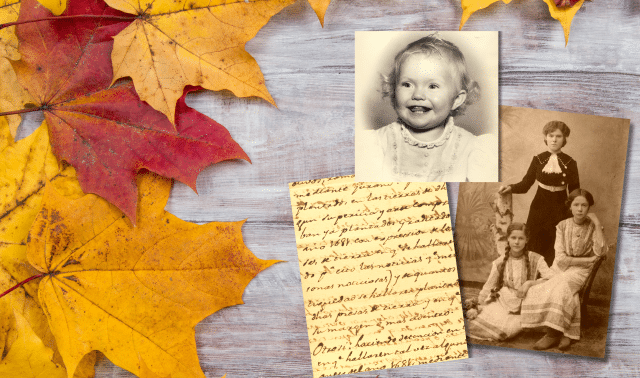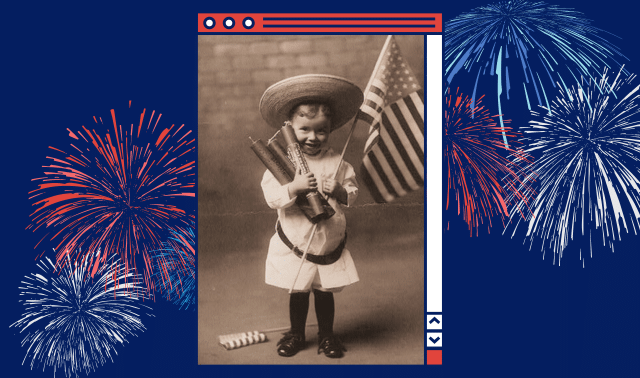Sign up for the Family Tree Newsletter! Plus, you’ll receive our 10 Essential Genealogy Research Forms PDF as a special thank you.
Get Your Free Genealogy Forms
"*" indicates required fields

As genealogists know, heirlooms are meaningful objects passed down within a family from generation to generation.
Heirlooms are a lot like the lottery: If you’re lucky, you’ll be the relative who gets a huge payoff, such as cousin Vivian’s 1920s college scrapbook or Uncle John’s Civil War diary. If you’re like me, however, you’re the unfortunate family member who missed out on all the loot. My family didn’t keep any of its treasures. And when I see the family history riches my friends have inherited, I feel like Charlie Brown on Halloween, as he peered into his trick-or-treat bag and whined, “I got a rock.”
My descendants won’t be heirloom-impoverished, though. In the absence of artifacts passed down from my ancestors, I’ve come up with some creative alternatives — and so can you. To get you started, I’ve outlined 9 keepsakes you can make or buy. Try these ideas, and you’ll end up with a wealth of “artifacts” to hand down to future generations.
1. Scrapbooks
Creating a heritage album — a scrapbook that documents your ancestors’ stories — is the most obvious way to record your family history and pass on a valuable heirloom.
In fact, any scrapbook you create can become a family heirloom, no matter what the album’s focus. How-to books outline hundreds of scrapbook themes, from baby books to vacation albums. Or use your imagination to create your own genealogy theme: an “atlas” containing maps of ancestral towns, a collection of family letters, an album commemorating a particular time period.
You could simply compile representative photographs of each generation of family members, clearly labeling and identifying each person.
2. Dishes
My most treasured family heirlooms are the dishes my grandmother got in boxes of detergent or at the dime store. They’re not bone china — they’re the ones the family used day in and day out.
Although it’d be nice to hand down a whole set of dishes to one family member, splitting up the set so each descendant can have a cup or bowl is fine. Don’t have a set of oft-used dishes? Consider buying plates, teapots or other special pieces to display in your home. Your relatives will see the dishes around your house and associate them with you — and that’s what makes them treasured heirlooms.
Visit antiques stores for replica dishes you remember seeing in relatives’ homes as you were growing up. My grandmother used to have a set of juice glasses with painted oranges on them. I purchased a similar set — with a pitcher — at an antiques store. Even though these glasses weren’t Grandma’s, they still remind me of her. One day, I’ll pass them on to my daughter.
3. Souvenirs
When you go on vacation or take a trip, you feel obligated to buy souvenirs. Of course, those “indispensable” items usually end up in a box in the back of the closet, or on a shelf collecting dust. Before you throw them away or give them to Goodwill, think of relatives who might like to have them — and would treat those ephemera as family heirlooms.
Your souvenirs might tell stories of family vacations, your college days, special events or trips to ancestral homelands. Tell the person who’s inheriting that snow globe where you got it, what memories surround it and why it’s important to you. Better yet, write all that down, and give your memories and the item to one of your descendants. And as you visit new places, buy souvenirs that might make good keepsakes — perhaps items that identify a place or are collector’s items, such as a Christmas ornament with the year on it.
4. Letters
Even if you haven’t kept old correspondence with family and friends, you can start now. Letter writing is becoming a thing of the past, now that e-mails and phone calls make communicating easier and quicker — and that’s all the more reason to correspond the old-fashioned way. Use letters to preserve a form of communication, as well as family history. For instance, write a letter to the youngest person in your family for some special event, such as a birthday. Tell the youngster what life was like for you at that age. Be sure to keep a copy of the letter for yourself, and store it with other family items.
Or why not write a letter to a deceased relative to whom you were close? Tell her all the things you wish you could have said while she was still alive. You also could write to a per-son from your childhood who made a lasting impression on you: Record what you’d say if you were to see him today. In the letters, write your fondest memories of those people, what they meant to you and the effects they had on your life.
And remember: Even though typing on a word processor is convenient, your handwriting is part of a letter’s heirloom quality.
5. Recipe books
Most cooks have dozens of recipe books, but use just a few cookbooks over and over. You usually can identify favorite cookbooks by their grease marks, flour residue and dog-eared pages. Those tomes can do double duty as heirlooms.
When looking at recipe books as potential heirlooms, think about going back through the recipes you’ve tried and making notes in the margins, such as “too difficult to make,” “we really liked this one” or “substitute Italian sausage for ground beef.” Your annotations will make the cookbook more valuable to your descendants and will help them re-create your favorite recipes. Plus, they’ll have samples of your handwriting.
If you enjoy scrapbooking, consider creating a family-recipe scrapbook. Incorporate not only favorite foods, but also a short biography and photograph of each cook who prepared the recipes. If you have old family favorites that you’ve updated or altered for today’s eat-on-the-go lifestyle, include the original recipes and how you’ve adapted them. Add pictures of all the relatives at family feasts, and write captions recording typical family conversations. Design pages for recipes and foods served on holidays and special occasions, too.
6. Dolls and toys
Didn’t save any of your childhood dolls or toys to pass on to your kids and grandkids? Not to worry. Toy collecting is a popular hobby, which means you can track down that Chatty Cathy doll or Buck Rogers action figure on eBay and other Web sites. To help you remember popular playthings, consult a guide such as Mark Rich’s Toys A to Z: A Guide and Dictionary for Collectors, Antique Dealers and Enthusiasts (Krause Publications). Or pick up Girls’ Toys of the Fifties and Sixties and Boys’ Toys of the Fifties and Sixties, both edited by Thomas W. Holland (Windmill Press). These books contain reprints of the catalog pages from the legendary Sears Christmas Wish-books from 1950 to 1969.
Even if you can’t find or afford a toy like the one you used to play with, you can create an heirloom by simply sharing these books with youngsters and telling them — or better yet, writing — about your childhood playtime adventures.
7. Needlework
If you enjoy counted cross-stitch or needlepoint, try sewing your family tree. You’ll find patterns at your local crafts store. Or pick out a few finished pieces you’re particularly proud of, and designate those as family heirlooms. Be sure you “sign” and date each creation (either stitch your name on the project or affix a label to the back). Most important, tell the recipient you’d like your handiwork to be passed down in the family.
8. Diaries
Keeping a diary or journal may seem like a chore if you haven’t been doing it, but it doesn’t need to be. You don’t have to write in your journal daily or account for every thought, feeling and activity. You can write whenever the mood strikes you — about whatever you want. The point is to get a notebook or journal and write something. Tell what your favorite foods are, list books or movies you like, explain how you met and fell in love with your spouse. Consider buying one of those “legacy books” for parents and grandparents, which contain prompts to record your life story. You can fill that in, or simply use it to get ideas. Here again, a handwritten diary will be more interesting to your descendants than a computerized one — the penmanship is part of the diary’s ambiance.
9. Favorite magazines, books and comic books
It’s never too late to begin collecting special issues of magazines and comic books, or setting aside your favorite books to pass along to family members. For example, I began collecting the annual fall preview issues of TV Guide in the 1970s. It’s fun for me to browse through them, but I’m sure younger generations would get an even bigger kick out of the collection: Think how much they’d enjoy seeing how few channels and programs we had, and how listings noted whether the shows were in color or black and white. Now that it’s easy to track down old, out-of-print books, comic books and magazines via the Internet, you can replace your childhood favorites. If the prices exceed your budget, make a list of the publications you read as a child and include that with your journal or other keepsakes.
Of course, you’ll come up with more projects and purchases to designate as family heirlooms. You can choose any item that illustrates your family’s history, reflects your personality or evokes fond memories. The key is to make sure your family knows the object is a keepsake that you want to be handed down. So it’s always wise to create a written inventory with details about each item. That way, you can ensure that your descendants hit the family heirloom jackpot.
FamilyTreeMagazine.com is a participant in the Amazon Associates Program, an affiliate advertising program. It provides a means for this site to earn advertising fees, by advertising and linking to Amazon and affiliated websites.




